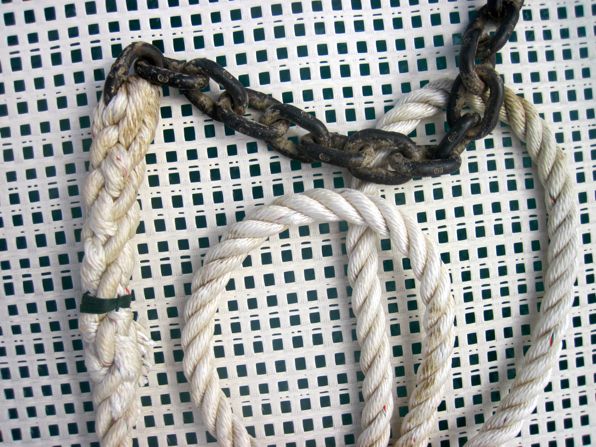End for end
When we first set out cruising we had 100′ of 5/16″ chain attached to 200′ of 5/8″ 3-strand nylon line to hold our anchor. We found that we were often able to anchor in shallow enough spots that, with 100′ of chain, we never had to ride on the line. Ever since we lost some chain by wrapping it around a submerged wreck in Boqueron, PR, that has not been the case. We now are always forced to ride on the nylon line when at anchor. We don’t really have a problem with that because our boat is so light but as you can see from the pics below, it is the same portion of line that is always in the water. The stuff at the bottom of the locker still looks brand new!
As Rebecca was busy with other tasks yesterday morning, I took it upon myself to swap the anchor line end for end. That first step to doing so was shortening up the scope of our anchor to probably only 3:1 so that I had access to the end of the chain where the line was spliced to it. Fortunately we were in shallow enough water to allow us to do this. The chain to rope splice is one of those things that I do so infrequently that I almost needed to relearn it all over again. Almost. It’s really just getting it started that’s the tough part. I practiced by first making a new bridle “key” (that’s what I now call the short length of line spliced to a small piece of chain that I use to connect the rode to our chain plate). After I was happy with that splice I went ahead and cut the 3-strand from the end of our anchor chain. The process to reconnect them is not all that difficult but it took a bit of time to get it perfect and it’s not something that I wanted to take shortcuts on. When at anchor this is the only thing that keeps ZTC safely off the rocks! After the splice was completed and looking pretty, the last step was to re-mark the anchor rode (with colored tie wraps) so that we can easily tell how much we’re putting out when we’re anchoring. Not a bad morning job to check off the list.

It’s easy to see the portion of the line that has never been in the water.

Borrowed from the galley.

A new bridle “key.”

The completed splice, tapered so that it slides through the windlass without jamming.

Colored tie wraps mark the line every 25 feet.




So I expect that next time you will be telling us that you are putting all the lines in the washing machine so that they are all nice and white, and soft to the touch! 🙂
Mike
hehe… not likely.
Actually, people have put their rodes in the washer, finishing with fabric softener, to get the salt out of them! Nice looking splices, Mike.
I’ve written about that before actually although have never done it. If we were to ever do it we’d do it by hand, not in a machine. Living in the land of “limited fresh water” though the chances of that happening are nil.
I wrote an article for Practical Sailor (publish this past summer) on washing ropes. There will be a follow-up on post treatments/fabric softner this fall. I posted a VERY short version (http://sail-delmarva.blogspot.com/2010/03/line-washing.html). It was fun, I ended up with a lot of free rope, and because I washed every sort of line every way I could think of, I got to see all of the mistakes I got to fix the washer (clogged with rope bits and marine life). We looked at nearly 100 permutations.
*Avoid machines. The carnage was impressive. A pillow and gentle cycle case helps, but it was always a slight risk. Docklines were particularly vulnerable (nylon double braid).
* Make sure the end whippings are good. 3-strand can hockle in a machine.
* Fabric softner is a waste of time. Rope-Pruf (http://sail-delmarva.blogspot.com/2010/03/line-washing.html) is MUCH better for running rigging, and anchor ropes should only be washed.
* Avoid any sort of lime-removing treatments; they are acid and destroy nylon. The chelating agents in ordinary detergents took all of the lime out of all of the test ropes, and some were so stiff before washing, they seemed like wood.
* Daisy chains work better than coils, both for protecting the rope and for better cleaning. Although it did not happen to me, I’ve been told by the manufacturers that un-bagged rope can wrap around the center agitator and rip it out.
What lessons did I personally put into practice from the study?
* I never washed ropes before and nothing has changed.
* I do use Rope-pruf on older sheets. They handle better, squeak less for about 2 years, and it’s easy.
I was actually going to look up your post and link it to that comment. Keep up the great research, Drew!
Here’s a silly question for you, Mike: what’s the “bridle key” for? I don’t quite understand how you use it or why it’s necessary.
Hi Ernesto
Look at the pics in this post:
http://www.zerotocruising.com/ghosting-along/
And that’s not at all a silly question since I just made up the term bridle key.